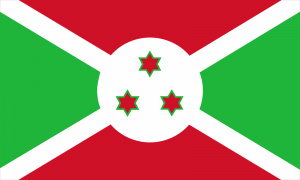Language/Rundi/Culture/History-and-Traditions
| ◀️ Asking for Directions — Previous Lesson | Next Lesson — Music and Dance ▶️ |
Introduction: Welcome to the lesson on the history and traditions of Burundi! In this lesson, we will explore the rich cultural heritage of Burundi and how it influences modern Rundi society. Understanding the history and traditions of a country is essential for learning a language, as it provides valuable insights into the people and their way of life. By delving into the historical events and cultural practices of Burundi, you will gain a deeper appreciation for the Rundi language and its connection to the country's past. So let's embark on this journey of discovery and immerse ourselves in the fascinating world of Burundian culture!
Historical Overview: To truly understand Burundian culture, we must first take a step back in time and explore the country's history. Burundi is a landlocked country in East Africa, bordered by Rwanda, Tanzania, and the Democratic Republic of the Congo. It is believed that the region has been inhabited since the Paleolithic era, with evidence of early human settlements dating back thousands of years. However, it was during the 16th century that the Kingdom of Burundi emerged as a powerful and influential state in the region. Led by a series of strong rulers, the kingdom flourished and established a highly centralized system of governance.
One of the most significant historical events in Burundi's history was the arrival of European colonial powers in the late 19th century. The Germans were the first to establish a presence in Burundi, followed by the Belgians. The colonial period brought about significant changes in the country, including the introduction of Christianity and Western education. It also led to the division of the region into ethnic groups, a legacy that continues to shape the country's social dynamics today.
Cultural Traditions: Burundi is renowned for its vibrant and diverse cultural traditions. These traditions are deeply rooted in the country's history and have been passed down through generations. One of the most prominent cultural practices in Burundi is the performance of traditional dances. Dance plays a central role in Burundian culture and is used to celebrate various occasions, such as weddings, harvest festivals, and other important events. Traditional dances are characterized by their energetic movements, rhythmic drumming, and colorful costumes.
Another important aspect of Burundian culture is the art of storytelling. Storytelling has been a means of preserving history, passing down knowledge, and entertaining communities for centuries. Through oral traditions, myths, legends, and folktales, the stories of Burundi's past are kept alive. These stories often convey moral lessons and teach important values to the younger generation.
Burundi is also known for its unique traditional clothing. The women of Burundi wear a distinctive dress called the "imvutano." This dress is made of colorful fabric and is worn with a matching headscarf. The imvutano is not only a symbol of cultural identity but also reflects the status and social standing of the wearer. Men traditionally wear a loose-fitting tunic known as the "kitenge" or "ishabure."
Cultural Variations: While Burundi has a rich and diverse culture, it is important to note that there are regional variations in the usage and understanding of certain cultural practices. These variations are often influenced by historical factors and the presence of different ethnic groups within the country. For example, the drumming traditions in the northern region of Burundi differ from those in the south. Similarly, the style of traditional dances may vary depending on the ethnic group performing them.
It is also worth mentioning that the history of Burundi has been marked by periods of conflict and political instability. These historical events have had a profound impact on the cultural fabric of the country, shaping its traditions and social dynamics. Understanding these historical reasons can provide valuable insights into the cultural variations that exist within Burundi.
Interesting Facts: - Burundi is often referred to as the "Heart of Africa" due to its location in the center of the continent. - The national dish of Burundi is called "biharage," which is a stew made with beans, meat, and vegetables. - Burundi is home to the famous "Royal Drummers of Burundi," a traditional drumming group that has gained international recognition for their mesmerizing performances. - The country is known for its beautiful landscapes, including the stunning Lake Tanganyika, which is the second deepest lake in the world. - Burundi has a strong oral tradition and is home to many talented poets and storytellers.
Exercises: 1. True or False: Burundi is a landlocked country in East Africa. 2. Which European powers established a presence in Burundi during the colonial period? 3. What role does dance play in Burundian culture? 4. Describe the traditional clothing worn by women in Burundi. 5. Name one famous natural landmark in Burundi.
Exercise Solutions: 1. True 2. The Germans and the Belgians 3. Dance is used to celebrate various occasions and is characterized by energetic movements, rhythmic drumming, and colorful costumes. 4. Women wear a dress called the "imvutano" with a matching headscarf. 5. Lake Tanganyika
In this lesson, we have explored the history and traditions of Burundi, gaining a deeper understanding of the cultural heritage that influences modern Rundi society. By understanding the historical events and cultural practices of Burundi, you are better equipped to appreciate the Rundi language and its connection to the country's past. Remember to embrace the diversity and richness of Burundian culture as you continue your journey of learning the Rundi language.
Sources[edit | edit source]
Other Lessons[edit | edit source]
| ◀️ Asking for Directions — Previous Lesson | Next Lesson — Music and Dance ▶️ |

